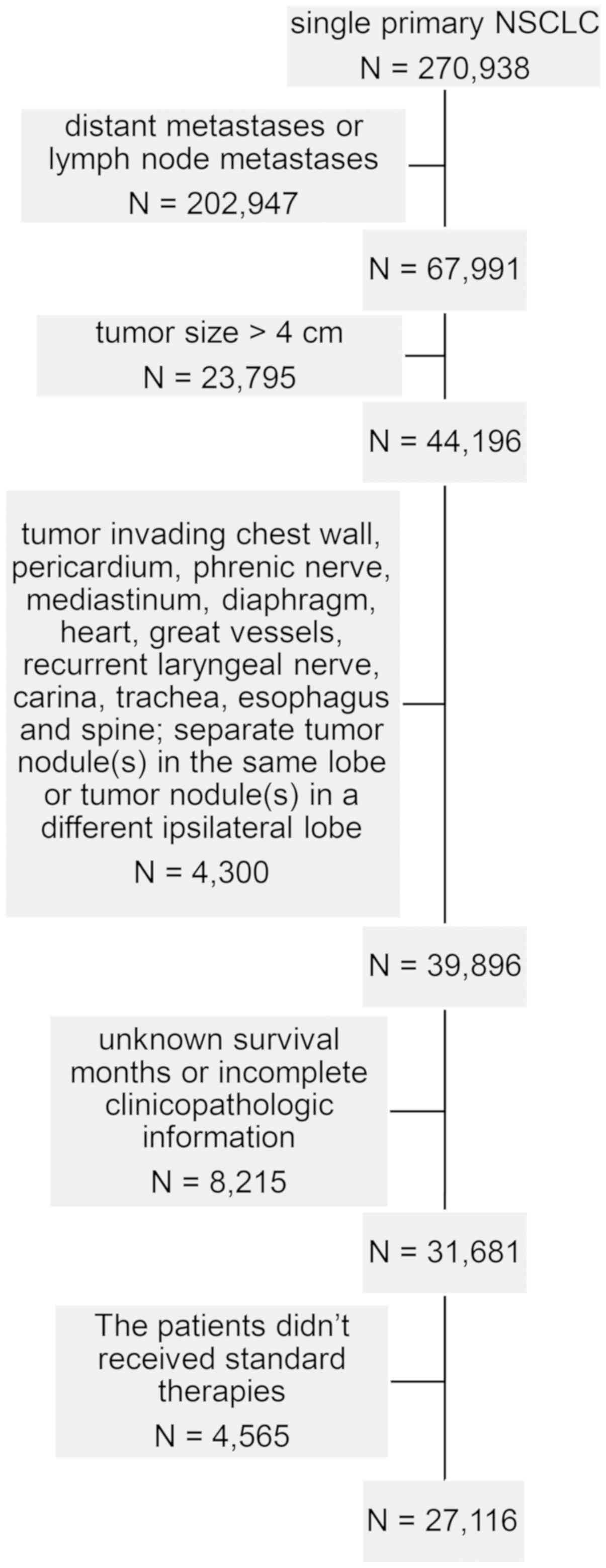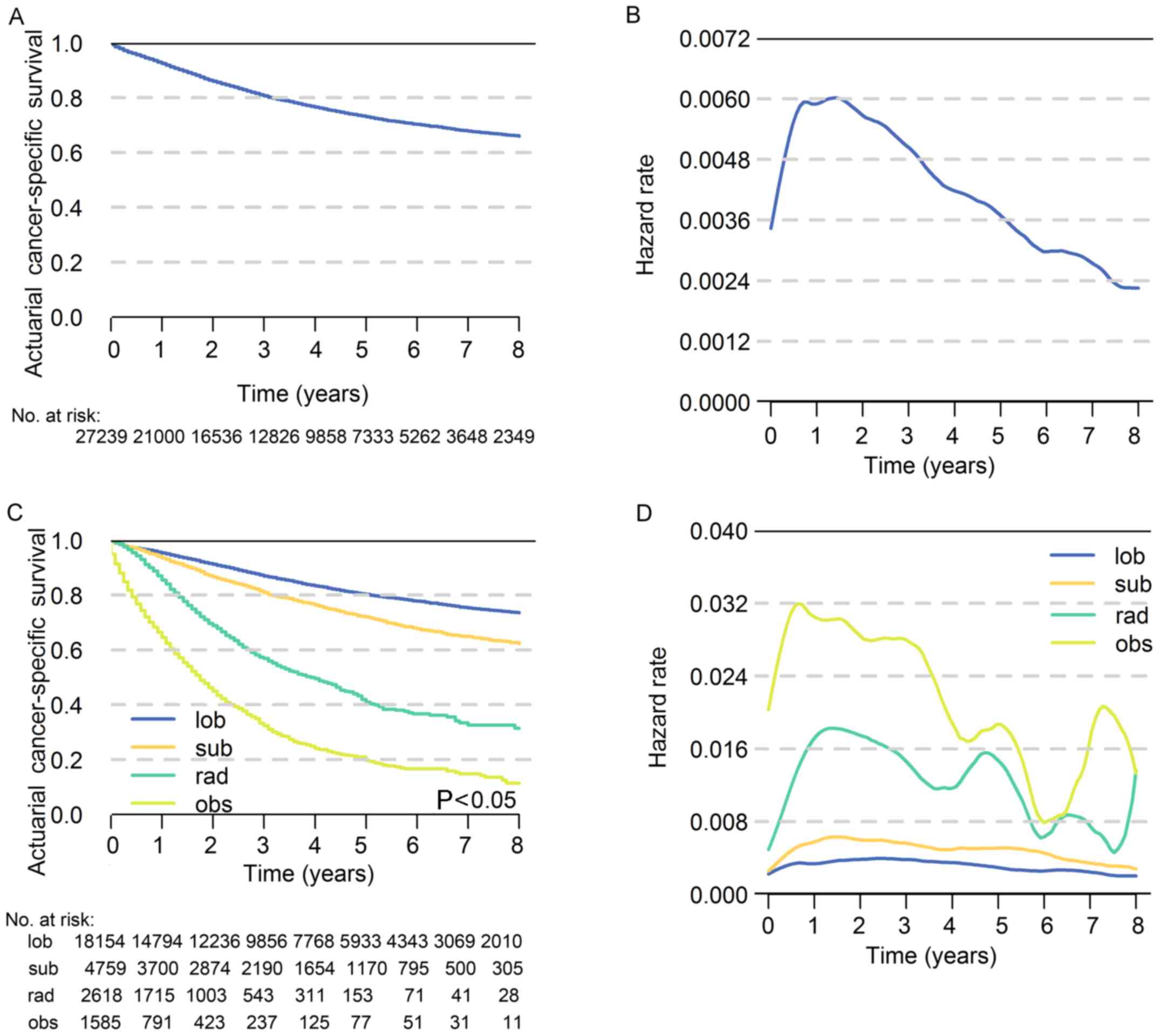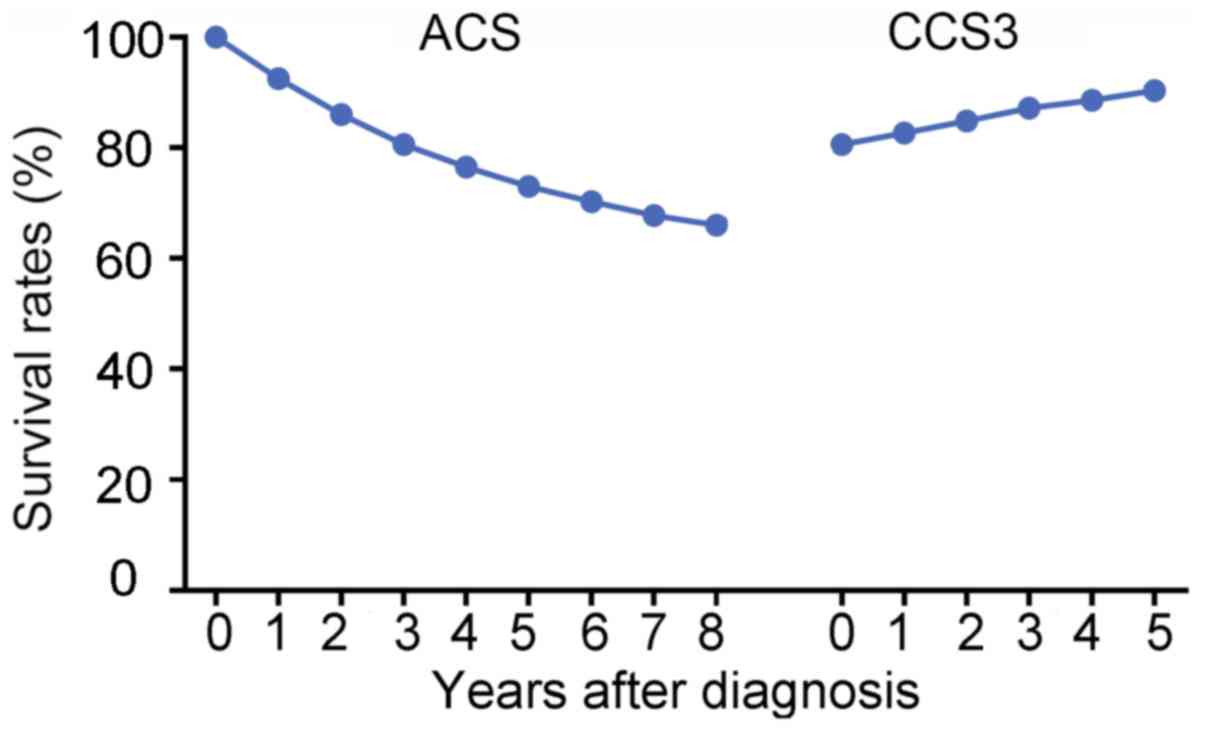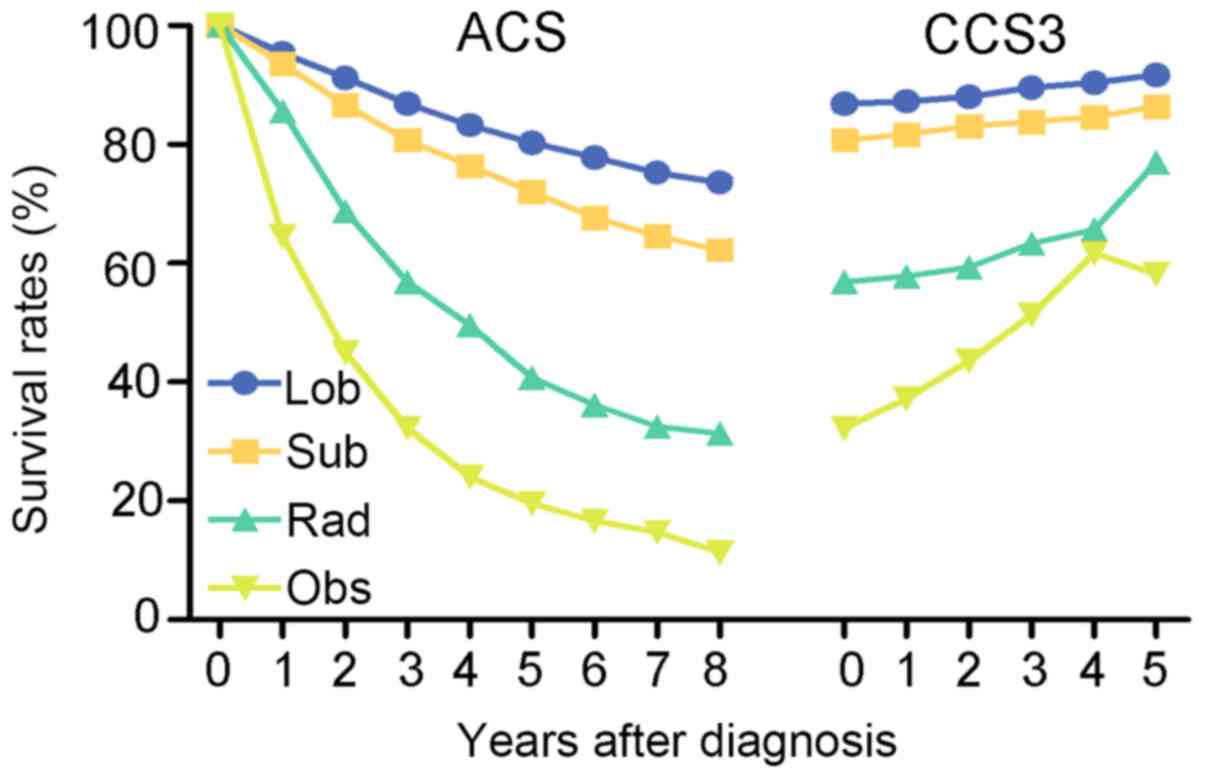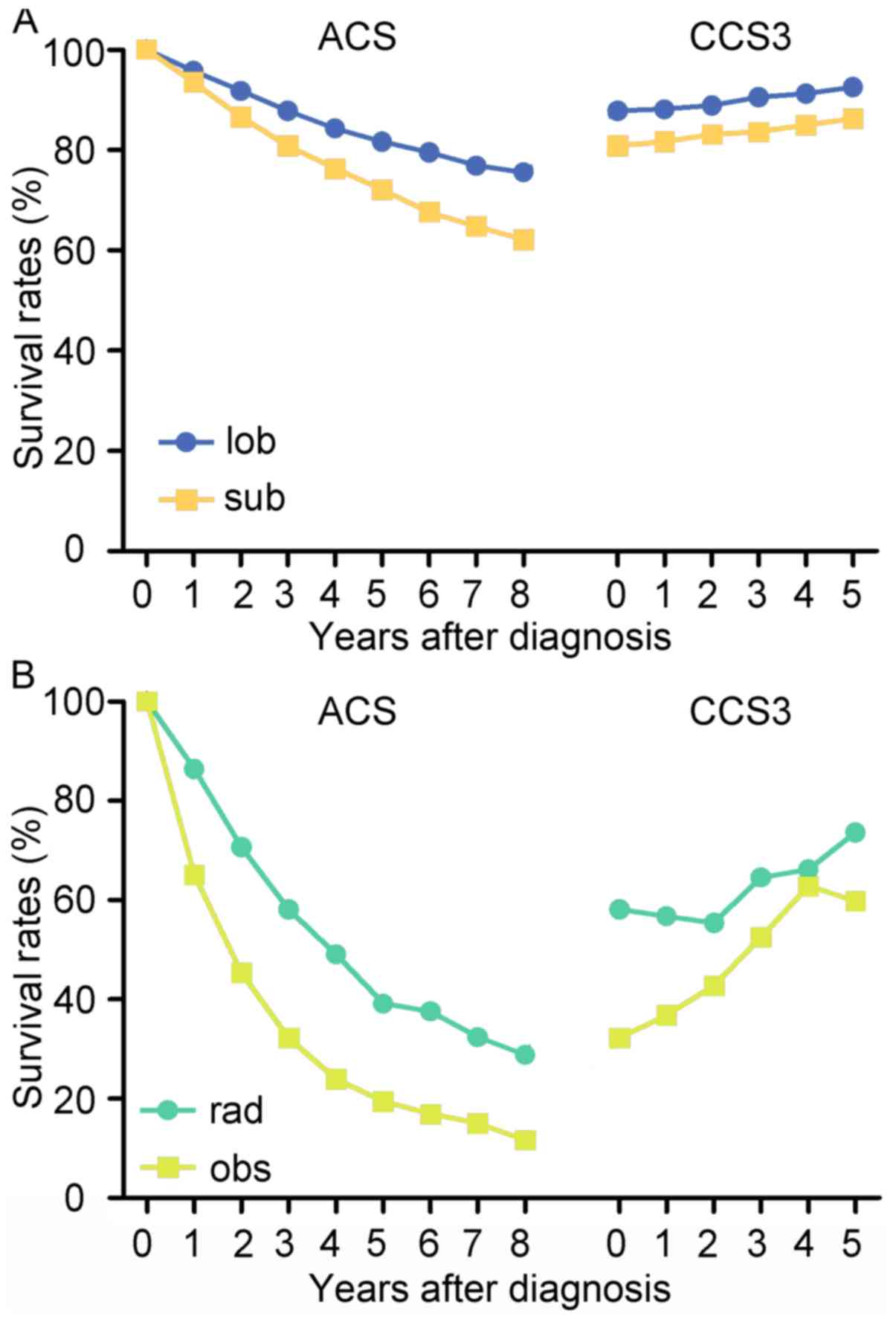|
1
|
Owonikoko TK, Ragin CC, Belani CP, Oton
AB, Gooding WE, Taioli E and Ramalingam SS: Lung cancer in elderly
patients: An analysis of the surveillance, epidemiology, and end
results database. J Clin Oncol. 25:5570–5577. 2007. View Article : Google Scholar : PubMed/NCBI
|
|
2
|
Howington JA, Blum MG, Chang AC, Balekian
AA and Murthy SC: Treatment of stage I and II non-small cell lung
cancer: Diagnosis and management of lung cancer, 3rd ed: American
College of Chest Physicians evidence-based clinical practice
guidelines. Chest. 143 (Suppl 5):e278S–e313S. 2013. View Article : Google Scholar : PubMed/NCBI
|
|
3
|
Dikken JL, Baser RE, Gonen M, Kattan MW,
Shah MA, Verheij M, va de Velde CJ, Brennan MF and Coit DG:
Conditional probability of survival nomogram for 1-, 2-, and 3-year
survivors after an R0 resection for gastric cancer. Ann Surg Oncol.
20:1623–1630. 2013. View Article : Google Scholar : PubMed/NCBI
|
|
4
|
Henson DE and Ries LA: On the estimation
of survival. Semin Surg Oncol. 10:2–6. 1994. View Article : Google Scholar : PubMed/NCBI
|
|
5
|
Wang SJ, Fuller CD and Thomas CR Jr:
Ethnic disparities in conditional survival of patients with
non-small cell lung cancer. J Thorac Oncol. 2:180–190. 2007.
View Article : Google Scholar : PubMed/NCBI
|
|
6
|
Skuladottir H and Olsen JH: Conditional
survival of patients with the four major histologic subgroups of
lung cancer in Denmark. J Clin Oncol. 21:3035–3040. 2003.
View Article : Google Scholar : PubMed/NCBI
|
|
7
|
Merrill RM, Henson DE and Barnes M:
Conditional survival among patients with carcinoma of the lung.
Chest. 116:697–703. 1999. View Article : Google Scholar : PubMed/NCBI
|
|
8
|
Chen F, Cole P and Bina WF: Time trend and
geographic patterns of lung adenocarcinoma in the United States,
1973–2002. Cancer Epidemiol Biomarkers Prev. 16:2724–2729. 2007.
View Article : Google Scholar : PubMed/NCBI
|
|
9
|
Kim W, Lee HY, Jung SH, Woo MA, Kim HK,
Choi YS, Kim J, Zo JI, Shim YM, Han J, et al: Dynamic
prognostication using conditional survival analysis for patients
with operable lung adenocarcinoma. Oncotarget. 8:32201–32211.
2017.PubMed/NCBI
|
|
10
|
Shirvani SM, Jiang J, Chang JY, Welsh JW,
Gomez DR, Swisher S, Buchholz TA and Smith BD: Comparative
effectiveness of 5 treatment strategies for early-stage non-small
cell lung cancer in the elderly. Int J Radiat Oncol Biol Phys.
84:1060–1070. 2012. View Article : Google Scholar : PubMed/NCBI
|
|
11
|
National Cancer Institue: Surveillance,
Epidemiology, and End Results (SEER) Program. http://seer.cancer.govApril. 2017
|
|
12
|
Parzen JS, Bates JE, Milano MT and Dhakal
S: Survival after subsequent non-Hodgkin's lymphoma and non-small
cell lung cancer in patients with malignant thymoma. J Thorac Dis.
8:3605–3613. 2016. View Article : Google Scholar : PubMed/NCBI
|
|
13
|
Fitz A, Percy C, Jack A, Shanmugaratnam K,
Sobin L, Max Parkin D and Whelan S: ICD-O-3: International
classification of Diseases for Oncology. 3rd. World Health
Organization; Geneva: 2000
|
|
14
|
Detterbeck FC, Boffa DJ, Kim AW and Tanoue
LT: The eighth edition lung cancer stage classification. Chest.
151:193–203. 2017. View Article : Google Scholar : PubMed/NCBI
|
|
15
|
Austin PC: Statistical criteria for
selecting the optimal number of untreated subjects matched to each
treated subject when using many-to-one matching on the propensity
score. Am J Epidemiol. 172:1092–1097. 2010. View Article : Google Scholar : PubMed/NCBI
|
|
16
|
Merrill RM, Henson DE and Ries LA:
Conditional survival estimates in 34,963 patients with invasive
carcinoma of the colon. Dis Colon Rectum. 41:1097–1106. 1998.
View Article : Google Scholar : PubMed/NCBI
|
|
17
|
Henson DE, Ries LA and Carriaga MT:
Conditional survival of 56,268 patients with breast cancer. Cancer.
76:237–242. 1995. View Article : Google Scholar : PubMed/NCBI
|
|
18
|
Nathan H, de Jong MC, Pulitano C, Ribero
D, Strub J, Mentha G, Gigot JF, Schulick RD, Choti MA, Aldrighetti
L, et al: Conditional survival after surgical resection of
colorectal liver metastasis: An international multi-institutional
analysis of 949 patients. J Am Coll Surg. 210:755–764. 2010.
View Article : Google Scholar : PubMed/NCBI
|
|
19
|
Sun M, Trinh QD and Karakiewicz PI:
Conditional survival of patients with metastatic renal-cell
carcinoma. Lancet Oncol. 13:e4622012. View Article : Google Scholar : PubMed/NCBI
|
|
20
|
Wang SJ, Emery R, Fuller CD, Kim JS,
Sittig DF and Thomas CR: Conditional survival in gastric cancer: A
SEER database analysis. Gastric Cancer. 10:153–158. 2007.
View Article : Google Scholar : PubMed/NCBI
|
|
21
|
Mayo SC, Nathan H, Cameron JL, Olino K,
Edil BH, Herman JM, Hirose K, Schulick RD, Choti MA, Wolfgang CL
and Pawlik TM: Conditional survival in patients with pancreatic
ductal adenocarcinoma resected with curative intent. Cancer.
118:2674–2681. 2012. View Article : Google Scholar : PubMed/NCBI
|
|
22
|
Kim Y, Ejaz A, Spolverato G, Squires MH,
Poultsides G, Fields RC, Bloomston M, Weber SM, Votanopoulos K,
Acher AW, et al: Conditional survival after surgical resection of
gastric cancer: A multi-institutional analysis of the us gastric
cancer collaborative. Ann Surg Onco. 22:557–564. 2015. View Article : Google Scholar
|
|
23
|
Kim Y, Margonis GA, Prescott JD, Tran TB,
Postlewait LM, Maithel SK, Wang TS, Glenn JA, Hatzaras I, Shenoy R,
et al: Curative Surgical Resection of Adrenocortical Carcinoma:
Determining long-term outcome based on conditional disease-free
probability. Ann Surg. 265:197–204. 2017. View Article : Google Scholar : PubMed/NCBI
|
|
24
|
Lee JW, Ali B, Yoo HM, Park CH and Song
KY: Conditional survival analysis in Korean patients with gastric
cancer undergoing curative gastrectomy. BMC Cancer. 15:10052015.
View Article : Google Scholar : PubMed/NCBI
|
|
25
|
Merrill RM and Hunter BD: Conditional
survival among cancer patients in the United States. Oncologist.
15:873–882. 2010. View Article : Google Scholar : PubMed/NCBI
|
|
26
|
Ito Y, Miyashiro I, Ito H, Hosono S,
Chihara D, Nakata-Yamada K, Nakayama M, Matsuzaka M, Hattori M,
Sugiyama H, et al: Long-term survival and conditional survival of
cancer patients in Japan using population-based cancer registry
data. Cancer Sci. 105:1480–1486. 2014. View Article : Google Scholar : PubMed/NCBI
|
|
27
|
Ginsberg RJ and Rubinstein LV: Randomized
trial of lobectomy versus limited resection for T1 N0 non-small
cell lung cancer. Lung Cancer Study Group. Ann Thorac Surg.
60:622–613. 1995. View Article : Google Scholar
|
|
28
|
Martin JT, Durbin EB, Chen L, Gal T, Mahan
A, Ferraris V and Zwischenberger J: Nodal upstaging during lung
cancer resection is associated with surgical approach. Ann Thorac
Surg. 101:238–245. 2016. View Article : Google Scholar : PubMed/NCBI
|
|
29
|
Villamizar N and Swanson SJ: Lobectomy vs.
Segmentectomy for NSCLC (T<2 cm). Ann Cardiothorac Surg.
3:160–166. 2014.PubMed/NCBI
|
|
30
|
Kohman LJ, Gu L, Altorki N, Scalzetti E,
Veit LJ, Wallen JM and Wang X: Biopsy first: Lessons learned from
cancer and leukemia Group B (CALGB) 140503. J Thorac Cardiovasc
Sury. 153:1592–1597. 2017. View Article : Google Scholar
|
|
31
|
Suzuki K, Saji SH, Aokage K, Watnabe SI,
Okada M, Mizusawa J, Nakajima R, Tsuboi M, Nakamura S, Nakamura K,
et al: Comparison of morbidity of pulmonary segmentectomy and
lobectomy: Safety results of a randomized trial. J Thorac
Cardiovasc Surg. Apr 9–2019.(Epub ahead of print). doi:
10.1016/j.jtcvs.2019.03.090. View Article : Google Scholar
|
|
32
|
Dai C, Shen J, Ren Y, Zhong S, Zheng H, He
J, Xie D, Fei K, Liang W, Jiang G, et al: Choice of surgical
procedure for patients with non-small-cell lung cancer</=1 cm
or>1 to 2 cm among lobectomy, segmentectomy, and wedge
resection: A population-based study. J Clin Oncol. 34:3175–3182.
2016. View Article : Google Scholar : PubMed/NCBI
|
|
33
|
Whitson BA, Groth SS, Andrade RS, Maddaus
MA, Habermann EB and D'Cunha J: Survival after lobectomy versus
segmentectomy for stage I non-small cell lung cancer: A
population-based analysis. Ann Thorac Surg. 92:1943–1950. 2011.
View Article : Google Scholar : PubMed/NCBI
|
|
34
|
Cao J, Yuan P, Wang Y, Xu J, Yuan X, Wang
Z, Lv W and Hu J: Survival rates after lobectomy, segmentectomy and
wedge resection for the non-small cell lung cancer. Ann Thorac
Surg. 105:1483–1491. 2018. View Article : Google Scholar : PubMed/NCBI
|
|
35
|
Mery CM, Pappas AN, Bueno R, Colson YL,
Linden P, Sugarbaker DJ and Jaklitsch MT: Similar long-term
survival of elderly patients with non-small cell lung cancer
treated with lobectomy or wedge resection within the surveillance,
epidemiology, and end results database. Chest. 128:237–245. 2005.
View Article : Google Scholar : PubMed/NCBI
|
|
36
|
Noone AM, Lund JL, Mariotto A, Cronin K,
McNeel T, Deapen D and Warren JL: Comparison of SEER treatment data
with medicare claims. Med Care. 54:e55–e64. 2016. View Article : Google Scholar : PubMed/NCBI
|
|
37
|
Fukui T, Okasaka T, Kawaguchi K, Fukumoto
K, Nakamura S, Hakiri S, Ozeki N and Yokoi K: Conditional survival
after surgical intervention in patients with non-small cell lung
cancer. Ann Thorac Surg. 101:1877–1882. 2016. View Article : Google Scholar : PubMed/NCBI
|
|
38
|
Bosco JL, Silliman RA, Thwin SS, Geiger
AM, Buist DS, Prout MN, Yood MU, Haque R, Wei F and Lash TL: A most
stubborn bias: No adjustment method fully resolves confounding by
indication in observational studies. J Clin Epidemiol. 63:64–74.
2010. View Article : Google Scholar : PubMed/NCBI
|















